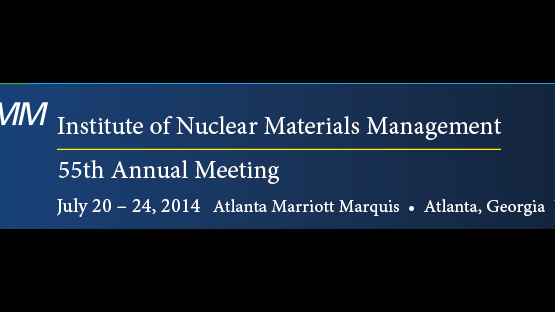Nuclear technologies have grown and matured considerably in recent decades, leading to an increasing range of applications for radioactive sources. Today, researchers and technical experts rely on these sources for industrial and agricultural purposes, radiotherapy, food sterilization, and more. However, once the material reaches the end-stages of its life, it must be carefully managed, and eventually disposed of in order to avoid contaminating the environment or endangering the public.
This process of managing radioactive sources from their initial production and distribution to their ultimate disposal is often called the "cradle-to-grave" approach. IAEA representatives will be presenting an ongoing, interregional technical cooperation (TC) project which emphasizes this management approach at the 55th annual meeting of the Institute of Nuclear Materials Management (INMM) in Atlanta, Georgia, USA.
From July 20-24, over 500 academic papers from 35 countries will be presented at the INMM annual summit. The meeting will provide a forum for the exchange of ideas and information on the newest technical breakthroughs related to all aspects of nuclear materials management. As a Sustaining Member of the institute, the IAEA has been invited to present its work under TC project INT9176, entitled 'Strengthening Cradle-to-Grave Control of Radioactive Sources in the Mediterranean Region'.
The project was initiated in January 2012, and boasts 21 participating Member States from three TC regions: Africa, Europe, and the Asia and the Pacific region. Its principal aim is to help ensure an adequate and permanent control over radioactive sources at the state-level, with efforts being made to harmonize regulatory practices in the region.
In alphabetical order, the participating countries are Albania, Bosnia and Herzegovina, Croatia, Cyprus, Egypt, Ghana, Greece, Jordan, Lebanon, Libya, Malta, Montenegro, Morocco, Nigeria, Serbia, Slovenia, South Africa, the Former Yugoslav Republic of Macedonia, Tunisia, Turkey, and the United Republic of Tanzania.
The Mediterranean is characterized by intense maritime trade between both littoral and land-locked countries. This trade may include radioactive sources or contaminated materials, both of which require an appropriate regulatory infrastructure if they are to be treated in a safe and secure manner. The majority of Member States in the area have already developed the groundwork for the control of radioactive sources and are implementing the provisions of the IAEA Code of Conduct on the Safety and Security of Sources. Nevertheless, in order to set up a robust "cradle-to-grave" management system, significant gaps still have to be filled.
The IAEA has implemented numerous national, regional, and interregional projects in the safe management of radioactive waste, and is drawing on this experience to help the participating Member States strengthen their existing policies, regulations and operational capabilities. The activities carried out as part of this TC project include efforts to update the regulatory framework, waste management infrastructure, and inventories of radioactive sources in each participating country.
Chief among the project's objectives is the furnishing of effective, scalable technologies to the participating Member States. For countries with no access to existing or planned disposal facilities, the only option for managing disused sealed radioactive sources (DSRS) is indefinite storage, which is an unsustainable technique. As part of this project, countries have been invited to explore the IAEA-developed Borehole Disposal Concept (BDC), an affordable technology for disposal of disused radioactive sources. The IAEA has also developed Mobile Hot Cell (MHC) technology, which helps to condition and prepare high-activity sources for disposal. Especially in countries where financial and human resources are limited, the IAEA is supplying both the physical equipment and software needed to support the project's goals.
Capacity building and training are both pivotal to the success of INT9176. Several training courses have been organized at the national and interregional levels, training more than 150 professionals in different aspects of source management. Wherever possible, hands-on training was provided in the form of practical exercises conducted in the field. National teams in Turkey and Egypt, for example, were tasked with recovering orphan sources and conditioning low-activity sources for storage, respectively. Furthermore, the training materials used locally, including safety requirements and self-assessments, are being reviewed and updated to meet the most recent IAEA standards.
Some of the participating Member States, however, have been confronted by unique challenges not found elsewhere. In order to address these concerns, international experts identified by the IAEA were sent to each country to directly support the establishment of national systems and infrastructure. More than 70 of these tailor-made expert missions have been launched, with many more to come.
To protect the public from the hazards of ionizing radiation, and to prevent disused sources from becoming orphan sources, "cradle to grave" control of radioactive sources is essential..
This requires a national policy and strategy, an adequate legal and regulatory framework, and adequate resources and infrastructure. For many years, the IAEA has been helping Member States to strengthen their national management and regulatory infrastructures to ensure that radioactive sources are properly controlled at all times.
In tandem with the European Union, national stakeholders, and other partners, the IAEA will continue to support this management practice worldwide.
| Project INT9/1/76 is carried out with funding by the European Union and the IAEA. |



